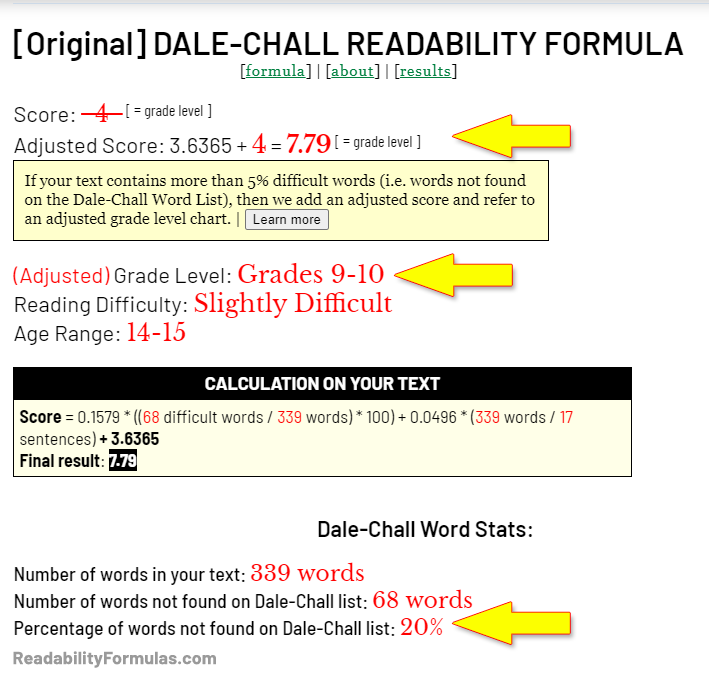The (Original) Dale-Chall Readability Formula was developed by Edgar Dale and Jeanne S. Chall in 1948 as a tool to estimate text difficulty and assess which age groups or grade levels could read the text. The formula uses two components: the percentage of difficult words (# of difficult words / # of words) and the average sentence length (ASL). The formula is as follows:
$$0.1579 \times 100 \times \frac{n_{wd}}{n_{w}} + 0.0496 \times ASL [+ 3.6365]$$
The Original Dale-Chall Readability Formula
To score a text, users compare the RI to grade-level thresholds. These thresholds are based on extensive testing with various grade-level students, and each grade level equals a specific RI range.
For example, a text with an RI between 4.9 and 5.9 is appropriate for students in the 5th grade.
Here is a list of specific Readability Index (RI) ranges:
| RI Range: 0 – 4.9 Grade Level: Kindergarten – 4th grade Reading Level: Beginner/Early elementary |
RI Range: 9.0 – 9.9 Grade Level: 9th grade Reading Level: High school |
| RI Range: 5.0 – 5.9 Grade Level: 5th grade Reading Level: Elementary |
RI Range: 10.0 – 10.9 Grade Level: 10th grade Reading Level: High school |
| RI Range: 6.0 – 6.9 Grade Level: 6th grade Reading Level: Elementary |
RI Range: 11.0 – 11.9 Grade Level: 11th grade Reading Level: High school |
| RI Range: 7.0 – 7.9 Grade Level: 7th grade Reading Level: Junior high/middle school |
RI Range: 12.0 – 12.9 Grade Level: 12th grade Reading Level: High school |
| RI Range: 8.0 – 8.9 Grade Level: 8th grade Reading Level: Junior high/middle school |
RI Range: 13.0 and above Grade Level: College level and beyond Reading Level: College/Advanced |
These ranges estimate the grade and reading levels associated with specific Readability Index scores.
Components of the Formula
This is how the Dale-Chall Formula calculates and interprets text:
Word Familiarity:
Analyzing text difficulty relies on word familiarity. The original formula used 763 familiar words known to fourth-grade students. The new formula uses 3,000 words that young and adult readers find familiar. Any word not on this list is flagged as unfamiliar. By counting the percentage of unfamiliar words in a text, the formula scores word difficulty in a nuanced way.
Sentence Length:
The formula factors in average sentence length. It assumes longer sentences increase text complexity. Sentence length is measured by the average number of words per sentence.
Adjusted Score:
To align readability scores with standard U.S. grade-levels, the formula introduced an adjustment number. Dale and Chall came up with this number through empirical research. It estimates grade levels more accurately, especially beyond 4th grade. If your text contains over 5% difficult words, then we use this formula:
RI = 0.1579 * PDW + 0.0496 * ASL + 3.6365 (adjusted score)
The formula adds 3.6365 to the score. The new score correlates to an adjusted grade level on the chart (shown below):
| ADJUSTED GRADE LEVEL CHART |
| ADJUSTED SCORE | GRADE LEVEL |
| 4.9 and Below | Grade 4 and Below |
| 5.0 to 5.9 | Grades 5 – 6 |
| 6.0 to 6.9 | Grades 7 – 8 |
| 7.0 to 7.9 | Grades 9 – 10 |
| 8.0 to 8.9 | Grades 11 – 12 |
| 9.0 to 9.9 | Grades 13 – 15 (College) |
| 10 and Above | Grades 16+ (College Grad) |
Below is a screenshot showing how the adjusted number rescores the grade level because the text contains 20% of difficult words.
Both versions of the Dale-Chall Formula are popular because of their simplicity and purpose. They both help educators match texts to students’ comprehension levels, and they both help authors shape their language to target their intended audience.
Don’t know which version to use? The original or the updated one? ReadabilityFormulas.com lets users score their text using both versions of Dale-Chall, using the same expanded word list of 3,000 words.
Score your text now, or learn more about the updated version of Dale-Chall.








